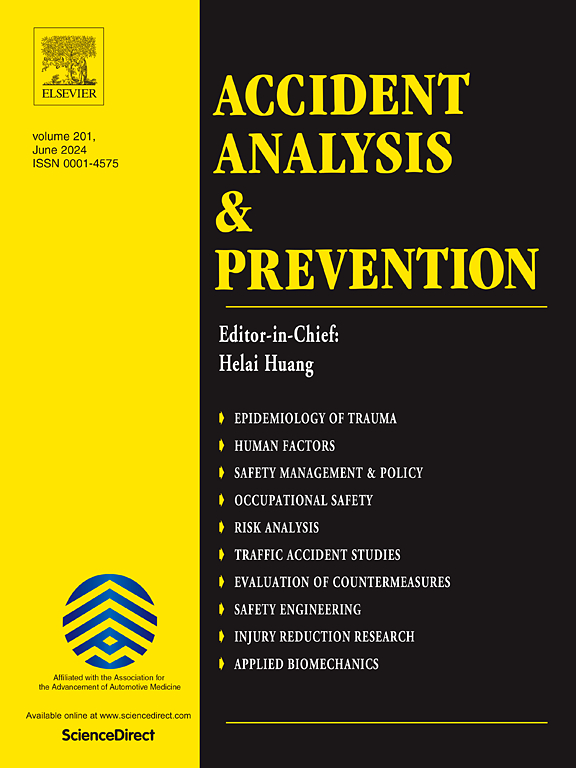A framework for real-time traffic risk prediction incorporating cost-sensitive learning and dynamic thresholds
IF 6.2
1区 工程技术
Q1 ERGONOMICS
引用次数: 0
Abstract
In recent years, researchers have explored an innovative approach that leverages real vehicle trajectory data to simultaneously derive traffic state and risk level for real-time risk prediction, which is crucial for traffic safety. However, existing studies largely overlook the costs associated with incorrect predictions and the varying consequences of different misclassifications, which undermines the reliability of the obtained prediction results. To address these gaps, this study refined traffic risk classification into four levels (i.e., no, low, medium, and high risks) and incorporated misclassification costs into the prediction process through cost-sensitive learning (CSL). Furthermore, considering that multi-class prediction tasks often face performance degradation and increased risk level granularity worsens class imbalance, further amplifying this degradation, this study introduced dynamic thresholds (DTs) to improve model performance. The aforementioned cost coefficients and thresholds were pinpointed using a genetic algorithm (GA). Furthermore, the employed data, comprising variables related to traffic state and associated risk data, were sourced from the HighD dataset. Subsequently, CSL-DTs-based models were built by integrating CSL and DTs with four distinct baseline machine/deep learning models, and the prediction performance (e.g., precision) and computation time of these models were compared. Results show that, compared to the corresponding baseline models, the proposed models perform better for multi-class prediction tasks. Additionally, the computation time of the CSL-DTs-based models is found to be acceptable for real-time prediction purposes. Finally, to ensure the reliability of the results obtained through the GA optimization (e.g., avoiding local optima), convergence curves were plotted, confirming the robustness of the optimization process. A robustness analysis also demonstrates that the models are highly stable under slight perturbations of cost coefficients and thresholds, with minimal impact on performance. Findings of this study are expected to enhance the reliability of real-time traffic risk prediction, holding the promise of significantly promoting proactive traffic safety management.
结合成本敏感学习和动态阈值的实时交通风险预测框架
近年来,研究人员探索了一种利用真实车辆轨迹数据同时获得交通状态和风险水平的创新方法,用于实时风险预测,这对交通安全至关重要。然而,现有的研究在很大程度上忽略了错误预测所带来的成本和不同错误分类的不同后果,这削弱了所获得的预测结果的可靠性。为了解决这些差距,本研究将交通风险分类细化为四个级别(即无风险、低风险、中风险和高风险),并通过成本敏感学习(CSL)将错误分类成本纳入预测过程。此外,考虑到多类预测任务经常面临性能下降的问题,增加风险级别粒度会加剧类不平衡,进一步放大这种下降,本研究引入动态阈值(dt)来提高模型性能。使用遗传算法(GA)确定上述成本系数和阈值。此外,所使用的数据,包括与交通状态和相关风险数据相关的变量,来自HighD数据集。随后,将CSL和dt与4种不同的基线机器/深度学习模型相结合,构建基于CSL- dt的模型,并比较这些模型的预测性能(如精度)和计算时间。结果表明,与相应的基线模型相比,本文提出的模型在多类预测任务中表现更好。此外,发现基于csl - dts的模型的计算时间可用于实时预测目的。最后,为了保证遗传算法优化结果的可靠性(如避免局部最优),绘制了收敛曲线,验证了优化过程的鲁棒性。鲁棒性分析还表明,在成本系数和阈值的轻微扰动下,模型高度稳定,对性能的影响最小。本研究结果有望提高交通风险实时预测的可靠性,对推进主动交通安全管理具有重要意义。
本文章由计算机程序翻译,如有差异,请以英文原文为准。
求助全文
约1分钟内获得全文
求助全文
来源期刊

Accident; analysis and prevention
Multiple-
CiteScore
11.90
自引率
16.90%
发文量
264
审稿时长
48 days
期刊介绍:
Accident Analysis & Prevention provides wide coverage of the general areas relating to accidental injury and damage, including the pre-injury and immediate post-injury phases. Published papers deal with medical, legal, economic, educational, behavioral, theoretical or empirical aspects of transportation accidents, as well as with accidents at other sites. Selected topics within the scope of the Journal may include: studies of human, environmental and vehicular factors influencing the occurrence, type and severity of accidents and injury; the design, implementation and evaluation of countermeasures; biomechanics of impact and human tolerance limits to injury; modelling and statistical analysis of accident data; policy, planning and decision-making in safety.
 求助内容:
求助内容: 应助结果提醒方式:
应助结果提醒方式:


